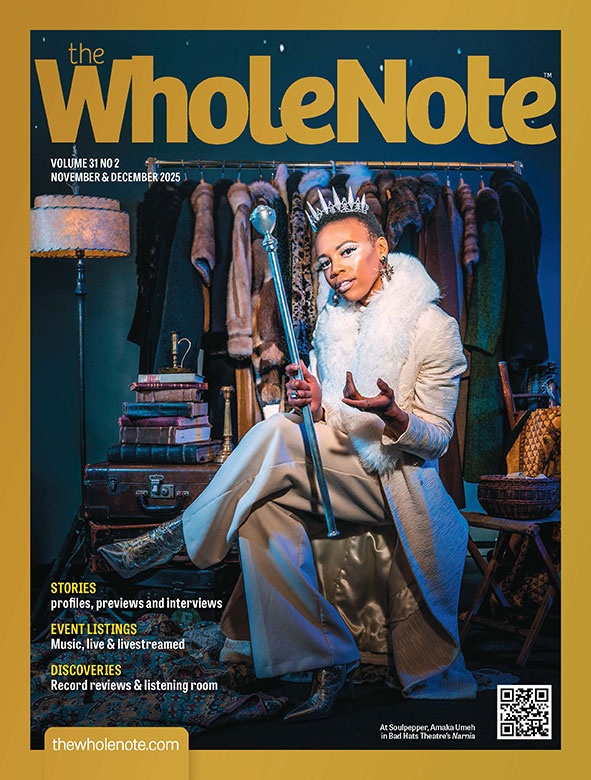Fall can be either a rough time or a good one to start feeling hopeful, depending on your point of view. Just like “back to school” means a lot of different things, depending where you are coming from and who is taking you there.
This year in particular, the season of first cold nights and falling leaves brings very mixed feelings. Alongside “fourth wave”pandemic dread that nothing will ever be “normal” again, is a glimmering hope that, yes indeed, there is a chance that some aspects of what we called normal are gone for good, because just like “back to school” what’s called normal depends on where you stand in relation to it.
Blue Pages
Normally, for more than 25 years in fact, the fall issue of The WholeNote has been “Blue Pages” time – a special supplement containing dozens of short profiles by music makers and presenters in our community, telling readers about themselves and their plans and hopes for the season underway. Individual profiles could be interesting or not to a reader, depending on your personal musical likes, but collectively they were always more than the sum of their parts, because they gave a comforting sense of who “we” were as a music community, chock-a-block with the familiar, but always offering up something new for the adventurous to explore.
One thing you could count on: when our Blue Pages members – usually more than 150 of them – said in the fall they were planning to do something over the course of the season, that was usually the way it worked out. Not so simple these days, as we all know.
So last year, instead of publishing one official October Blue Pages in the print magazine, we took the Blue Pages online, so music makers could wait till they were ready to announce their plans. Just as important, they’d be able to revise what they’d said if and when the COVID finger of fate summarily disposed of what they had bravely proposed. This year, we are doing the same.
Encouragingly, there are already 40 or so presenters who have taken the plunge: there’s an index of directory members so far on page 29. As always they are more than the sum of their parts: this year reflecting the same mix of hope and dread, tentativeness and caution bravely thrown to the winds, that we at The WholeNote and probably most of you are still feeling too.
Choosing a cover for the Blue Pages issue has always been a bit of a challenge: choosing a “flagbearer for the team” has never felt quite right. Why single out some particular ensemble or artist to grace the cover when the underlying message is that the community’s collective strength is greater than the sum of its individual parts, especially in these complex times?
Collectively, our ideas of what putting on or attending a concert means are being challenged as never before, along with our most comfortable assumptions of what constitutes “our” musical community. The need for good questions is largely what this issue’s cover is about.
Orange shirts
Yesterday (September 14, 2021) the Toronto Symphony Orchestra and Red Sky Theatre announced a joint project, titled Mistatim, in the works since late winter, to be launched on September 30, now officially Canada’s National Day for Truth and Reconciliation.
“[The show] is about a fast-paced horse who will gallop into the hearts of children” says Red Sky Theatre’s artistic director Sandra Laronde. “[It’s] a story of reconciliation that asks its audience, ‘Why tame and punish when we can learn to listen and seek to understand?’” Its release on September 30, she says, “is an opportunity to set the stage for children to dream about the kind of world they want to live in, and an opportunity for us to shift our perspectives in light of historical inequities, and equip young people with the vocabulary to continue these critical conversations about reconciliation and diversity.”
It is a new name for the day, but not a new observance. Under the name Orange Shirt Day it came to be in 2013, intended to promote awareness in Canada about the devastating impact of Canada’s residential school system on Indigenous communities for over a century – an impact that continues today.
As Orange Shirt Day it was a grassroots initiative arising organically from the testimony in spring 2013 of Phyllis (Jack) Webstad from the Stswecem’c Xgat’tem First Nation (Canoe Creek Indian Band) about her orange shirt, given to her by her grandmother and taken from her on entering “the Mission School” at age six or seven in 1973.
I suspect that Orange Shirt Day will not easily be dislodged as the name for the day. National Day for Truth and Reconciliation sounds too much like something you check off the calendar when it’s done – something maybe you only raise a glass to when there is finally, after
all the promises, clean drinkable water in every tap.
In my mind, I hear some baffled reader ask What does all that
have to do with music? Or theatre, or dance or live art of any kind?
Good question.




